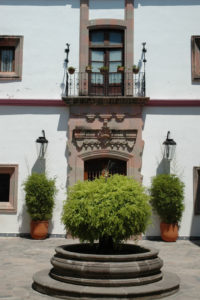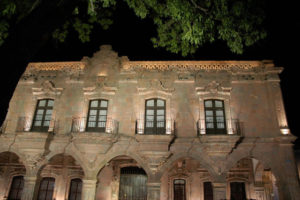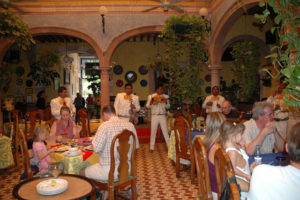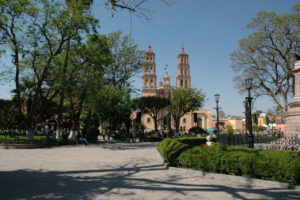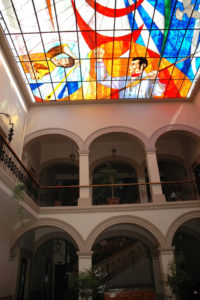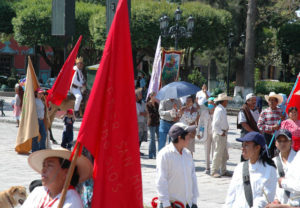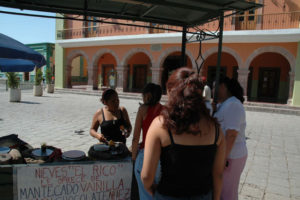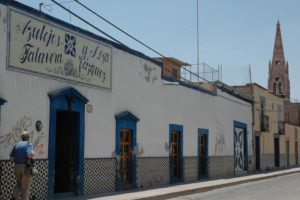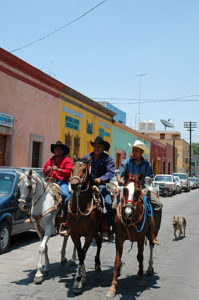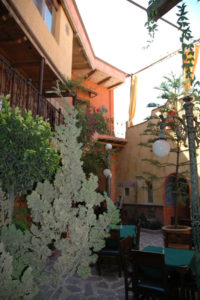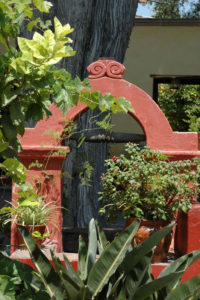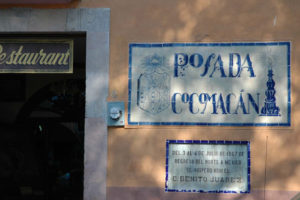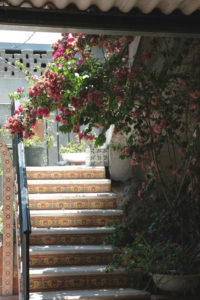Someone has mistakenly put shrimp into the ice cream or else I’m reading the sign incorrectly — always a possibility as my Spanish certainly needs some work. But then again, when I order camarones at restaurants, I get shrimp and so camarón must be shrimp, right?
But then what is it doing in the ice cream?
The answer, according to my guide book, is that I am in Dolores Hidalgo, a small historic village tucked away in the Guanajuato Mountains, and a place where people tend to get carried away with their ice cream flavors.
“¿Pulpo?” asks one of the many vendors who crowd together in the corners of Plaza Principal, the town’s central square — a charming oasis of greenery surrounded by an elaborate wrought iron fence.
Dolores Hidalgo is famed for their nieves or ice creams, all homemade and sold from carts that come out every day and set up in the town square, which is bordered on one side by the magnificent Parroquia de Nuestra Señora de los Dolores, an amazingly Churrigueresque style church with an elaborate facade of intricately carved pink figures and rose stucco walls that was built in the 1700s. My Spanish isn’t great but I know enough to understand that the flavor he is offering is octopus. I shake my head no.
“¿Camarones?” he asked next pointing to a container of ice cream with flecks of pink and red.
Oh what the heck. It’s only a few pesos and so I order the shrimp ice cream which the vendor scoops generously into a paper cup. I pick up a small wooden paddle spoon and take a taste. Not bad and, feeling more adventuresome, I look at the other containers, some 25 in all, and then at the list, written haphazardly on a piece of cardboard that is tacked to the side of the cart. My choices are many, from the typical — vanilla, strawberry, pecan and chocolate to the more exotic such as mango, papaya, tequila and avocado, to the fairly obscure — elote (corn), fried pork skin and pulque, a popular fermented drink. More flavors are frequently added as vendors compete with each other to come up with the truly unique. A visit to a stand at the northwest corner of the zócalo confirms this, as one of the offerings today is seafood mixture containing shrimp, octopus and other creatures of the deep. Dairy Queen aficionados would not be happy with this selection.
Loading up on several flavors, including chili, an interesting looking orange brown nieve that has a hint of heat, I walked towards the Parroquia de Nuestra Señora de los Dolores where a crowd is forming. Today is September 15th and almost 200 years ago, Father Don Miguel Hidalgo y Costilla delivered El Grito, an impassioned, spur of the moment cry for independence that started the Mexican revolution against Spanish rule. Every year, El Grito is re-enacted in this historic square whose buildings, dating back some three centuries, intrigue with their elaborate Baroque style. There’s the Visitor’s House, with its faded pinkish stone and five ground level arches topped by second story stone balconies. The nearby Museo de la Independencia, filled with artifacts from the historic struggle, is lit up at night, creating an appealing glow across the zócalo.
Dolores Hidalgo is one of 32 pueblos mágicos or “magical towns,” designated so because they are charming, historic and near major cities. In the case of Dolores Hidalgo, it is near Guanajuato, reasonably close to Querétaro and near another pueblo mágico, the incomparable San Miguel de Allende.
Like in many small Mexican towns, the downtown of Dolores Hidalgo is centered around a square where musicians play on Sundays. Families gather here to visit, sitting on wrought iron benches and enjoying the trueno and palm trees which shade the walkways. Because it is not a tourist destination for those across the border, Dolores Hidalgo retains much of the charm of old Mexico.
During my stay there, three charros rode down the cobbled streets on horseback, making their way to the courtyard restaurant of Hotel Posada de Las Campanas, which serves such traditional Mexican fare as chiles rellenos de queso, sopes (little baskets of fried masa topped with a variety of fillings including chorizo — a spicy Mexican sausage), tiny freshly made tortillas filled with savory chicken and pork, and flan, a custard like pudding topped with caramel sauce.
But there’s more to Dolores Hidalgo besides history, Baroque style architecture and fanciful flavored ice creams. Just blocks off of the zócalo, tucked away on quiet side streets are stores selling Talavera-style ceramics, a Mexican variation of the Spanish majolica pottery made in Puebla.
In an interesting aside, Father Hidalgo — an intellectual who was also considered a man of the people — introduced Talavera pottery techniques to the people of Dolores Hidalgo during the years he lived there, as well as silk worm raising, harness making, blacksmithing, weaving, leather tooling and wine and olive oil production. The stores, such as Talavera Cortés, La Casa de Las Artesanías and Talavera Vázquez, overflow with brightly patterned and colored Talavera-style products ranging from soap dishes, light switches, small vases and tiles, to large mosaics and bird baths, to the too-large-to-even-think-about-taking-home-on-the airplane pedestals and bathtubs and bathroom sinks.
The Talavera, no matter what the size, can be shipped home. Unfortunately, although I’ve developed a taste for papaya ice cream, the nieves cannot.

